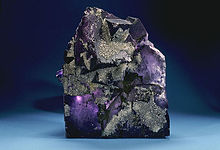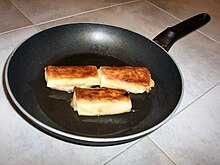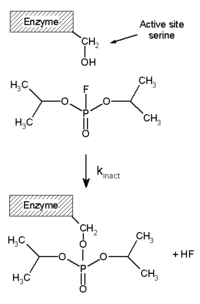Fluoride: Difference between revisions
No edit summary |
No edit summary |
||
| Line 1: | Line 1: | ||
{{about|the chemical ion ''F<sup>−</sup>''|the addition of fluoride ions to water supplies|Water fluoridation}} |
{{about|the chemical ion ''F<sup>−</sup>''|the addition of fluoride ions to water supplies|Water fluoridation}} |
||
'''Fluoride''' is the [[anion]] F<sup>−</sup>, the [[Redox|reduced]] form of [[fluorine]]. Both [[organic compounds|organic]] and [[inorganic]] compounds containing the [[chemical element|element]] fluorine are sometimes called fluorides. Fluoride, like other [[halide]]s, is a monovalent ion (−1 charge). Its compounds often have properties that are distinct relative to other halides. Chemically and structurally, the fluoride ion resembles [[hydroxide]]. Fluorine-containing compounds range from potent toxins such as [[sarin]] to life-saving pharmaceuticals such as [[efavirenz]] and from refractory materials such as [[calcium fluoride]] to the highly reactive [[sulfur tetrafluoride]]. The range of fluorine-containing compounds is considerable as fluorine is capable of forming compounds with all the elements except helium and neon.<ref>{{Greenwood&Earnshaw}} p. 804</ref><ref>{{cite journal | last = Khriachtchev | first = Leonid | coauthors = Mika Pettersson, Nino Runeberg, Jan Lundell & Markku Räsänen | date = [[24 August]] [[2000]] | title = A stable argon compound | journal = Nature | volume = 406 | pages = 874–876 | doi = 10.1038/35022551 | url = http://www.nature.com/nature/journal/v406/n6798/abs/406874a0.html }}</ref> |
'''Fluoride''' is the [[anion]] F<sup>−</sup>, the [[Redox|reduced]] form of [[fluorine]]. Both [[organic compounds|organic]] and [[inorganic]] compounds containing the [[chemical element|element]] fluorine are sometimes called fluorides. Fluoride, like other [[halide]]s, is a monovalent ion (−1 charge). Its compounds often have properties that are distinct relative to other halides. Chemically and structurally, the fluoride ion resembles the [[hydroxide]] ion. Fluorine-containing compounds range from potent toxins such as [[sarin]] to life-saving pharmaceuticals such as [[efavirenz]] and from refractory materials such as [[calcium fluoride]] to the highly reactive [[sulfur tetrafluoride]]. The range of fluorine-containing compounds is considerable as fluorine is capable of forming compounds with all the elements except helium and neon.<ref>{{Greenwood&Earnshaw}} p. 804</ref><ref>{{cite journal | last = Khriachtchev | first = Leonid | coauthors = Mika Pettersson, Nino Runeberg, Jan Lundell & Markku Räsänen | date = [[24 August]] [[2000]] | title = A stable argon compound | journal = Nature | volume = 406 | pages = 874–876 | doi = 10.1038/35022551 | url = http://www.nature.com/nature/journal/v406/n6798/abs/406874a0.html }}</ref> |
||
Compounds containing fluoride anions and in many cases those containing [[covalent bonds]] to fluorine are called fluorides. |
Compounds containing fluoride anions and in many cases those containing [[covalent bonds]] to fluorine are called fluorides. |
||
Revision as of 10:13, 3 August 2009
Fluoride is the anion F−, the reduced form of fluorine. Both organic and inorganic compounds containing the element fluorine are sometimes called fluorides. Fluoride, like other halides, is a monovalent ion (−1 charge). Its compounds often have properties that are distinct relative to other halides. Chemically and structurally, the fluoride ion resembles the hydroxide ion. Fluorine-containing compounds range from potent toxins such as sarin to life-saving pharmaceuticals such as efavirenz and from refractory materials such as calcium fluoride to the highly reactive sulfur tetrafluoride. The range of fluorine-containing compounds is considerable as fluorine is capable of forming compounds with all the elements except helium and neon.[1][2]
Compounds containing fluoride anions and in many cases those containing covalent bonds to fluorine are called fluorides.
Occurrence

Solutions of inorganic fluorides in water contain F− and bifluoride HF2−.[3] Few inorganic fluorides are soluble in water without undergoing significant hydrolysis. Examples of inorganic fluorides include hydrofluoric acid (HF), sodium fluoride (NaF), and uranium hexafluoride (UF6). In terms of its reactivity, fluoride differs significantly from chloride and other halides, and is more strongly solvated due to its smaller radius/charge ratio. Its closest chemical relative is hydroxide. The Si-F linkage is one of the strongest single bonds. In contrast, other silyl halides are easily hydrolyzed.
Many fluoride minerals are known, but paramount in commercial importance are fluorite and fluorapatite. Fluoride is found naturally in low concentration in drinking water and foods. Water with underground sources is more likely to have higher levels of fluoride, whereas the concentration in seawater averages 1.3 parts per million (ppm).[4] Fresh water supplies generally contain between 0.01-0.3 ppm, while the ocean contains between 1.2 and 1.5 ppm.[5]
Applications
Fluorides are pervasive in modern technology. Hydrofluoric acid is the most important fluoride synthesized. It is principally used in the production of fluorocarbons and aluminium fluorides. Hydrofluoric acid has a variety of specialized applications, including its ability to dissolve glass.[6]
Organic synthesis
Fluoride reagents are significant in synthetic organic chemistry. Due to the affinity of silicon for fluoride, and the ability of silicon to expand its coordination number, silyl ether protecting groups can be easily removed by the fluoride sources such as sodium fluoride and tetra-n-butylammonium fluoride (TBAF).
Enzyme inhibitors
In biochemistry, fluoride salts are commonly used to inhibit the activity of phosphatases, such as serine/threonine phosphatases.[7] It may do this by replacing the nucleophilic hydroxyl ion in these enzymes' active sites.[8] Beryllium fluoride and aluminium fluoride are also used as phosphatase inhibitors, since these compounds are structural mimics of the phosphate group and can act as analogues of the transition state of the reaction.[9][10]
Inorganic materials
Sulfur hexafluoride is an inert, nontoxic insulator that is used in electrical transformers. Uranium hexafluoride is used in the separation of isotopes of uranium between the fissile isotope U-235 and the non-fissile isotope U-238 in preparation of nuclear reactor fuel and atomic bombs. The volatility of fluorides of uranium and other elements may also be used for nuclear fuel reprocessing.

Fluoropolymers
Fluoropolymers such as polytetrafluoroethylene, Teflon, are used as chemically inert and biocompatible materials for a variety of applications, including as surgical implants such as coronary bypass grafts,[11] and a replacement for soft tissue in cosmetic and reconstructive surgery.[12] These compounds are also commonly used as non-stick surfaces in cookware and bakeware, and the fluoropolymer fabric Gore-Tex used in breathable garments for outdoor use.
Cavity prevention
Fluoride-containing compounds are used in topical and systemic fluoride therapy for preventing tooth decay. They are used for water fluoridation and in many products associated with oral hygiene.[13] Originally, sodium fluoride was used to fluoridate water; however, hexafluorosilicic acid (H2SiF6) and its salt sodium hexafluorosilicate (Na2SiF6) are more commonly used additives, especially in the United States. The fluoridation of water prevents tooth decay[14][15] and is considered by the U.S. Centers for Disease Control and Prevention as "one of 10 great public health achievements of the 20th century".[16] In some countries where large, centralized water systems are uncommon, fluoride is delivered to the populace by fluoridating table salt. Fluoridation of water is not without critics, however (see Opposition to water fluoridation).[17]

Biomedical applications
Positron emission tomography is commonly carried out using fluoride-containing pharmaceuticals such as fluorodeoxyglucose, which is labelled with the radioactive isotope fluorine-18 that emits positrons when it decays into 18O.
Fluorine is also part of a large variety of drugs including: antipsychotics such as fluphenazine, HIV protease inhibitors such as tipranavir, antibiotics such as ofloxacin and trovafloxacin, and anesthetics such as halothane.[18] These atoms are incorporated in the drug structures to reduce drug metabolism, as the strong C-F bond resists deactivation in the liver by cytochrome P450 oxidases.[19]
Toxicology
This article may need to summarize its corresponding main article in better quality. |
Fluoride-containing compounds are so diverse that it is not possible to generalize on their toxicity, which depends on their reactivity and structure, and in the case of salts, their solubility and ability to release fluoride ions.

Soluble fluoride salts, of which NaF is the most common, are mildly toxic but have resulted in both accidental and suicidal deaths from acute poisoning.[6] While the minimum fatal dose in humans is not known, a case of a fatal poisoning of an adult with 4 grams of NaF is documented.[20] Sodium fluorosilicate, Na2SiF6 with its higher fluorine content, can cause death with as little as 0.2 g.[citation needed] The fatal period ranges from 5 min to 12 hours.[20] The mechanism of toxicity involves the combination of the fluoride anion with the calcium ions in the blood to form insoluble calcium fluoride, resulting in hypocalcemia; calcium is indispensable for the function of the nervous system, and the condition can be fatal. Treatment may involve oral administration of dilute calcium hydroxide or calcium chloride to prevent further absorption, and injection of calcium gluconate to increase the calcium levels in the blood.[20] Hydrogen fluoride is more dangerous than salts such as NaF because it is corrosive and volatile, and can result in fatal exposure through inhalation or contact with the skin; calcium gluconate gel is the usual antidote.[21]
A few organofluorine compounds are extremely toxic, such as organophosphates like sarin and diisopropylfluorophosphate that react with the cholinesterase enzyme at neuromuscular junctions and thus block the transmission of nerve impulses to the muscles.[22] Here, a reactive fluorine-phosphorus bond in the inhibitor is the site of nucleophilic attack by a serine residue in the enzyme's active site, causing the loss of a F− ion and alkylation and inactivation of the enzyme.
While PTFE itself is chemically inert and non-toxic, it begins to deteriorate near or above 500 °F (260 °C), and decompose completely at temperatures above 660 °F (350 °C).[23] These degradation products can be lethal to birds, and can cause flu-like symptoms in humans.[23] In comparison, cooking fats, oils, and butter will begin to scorch and smoke at about 392 °F (200 °C), and meat is usually fried between 400–450 °F (200–230 °C), but empty cookware can exceed this temperature if left unattended on a hot burner.
A 1959 study, (conducted before the U.S. Food and Drug Administration approved the material for use in food processing equipment) showed that the toxicity of fumes given off by the coated pan on dry heating was less than that of fumes given off by ordinary cooking oils.[24]
See also
References
- ^ Greenwood, Norman N.; Earnshaw, Alan (1997). Chemistry of the Elements (2nd ed.). Butterworth-Heinemann. ISBN 978-0-08-037941-8. p. 804
- ^ Khriachtchev, Leonid (24 August 2000). "A stable argon compound". Nature. 406: 874–876. doi:10.1038/35022551.
{{cite journal}}: Check date values in:|date=(help); Unknown parameter|coauthors=ignored (|author=suggested) (help) - ^ Holleman, A. F.; Wiberg, E. "Inorganic Chemistry" Academic Press: San Diego, 2001. ISBN 0-12-352651-5.
- ^ Fluoride in Drinking-water: Background document for development of WHO Guidelines for Drinking-water Quality. World Health Organization, 2004, page 2. Page accessed on February 22, 2007.
- ^ Environmental Health Criteria 227: Fluorides. World Health Organization, 2002, page 38. Page accessed on February 22, 2007.
- ^ a b Aigueperse, Jean (2005). "Fluorine Compounds, Inorganic title = Ullmann's Encyclopedia of Industrial Chemistry". Wiley-VCH, Weinheim. p. 307. doi:10.1002/14356007.a11.
{{cite book}}: Missing or empty|title=(help); Missing pipe in:|chapter=(help); Unknown parameter|coauthors=ignored (|author=suggested) (help) - ^ Nakai C, Thomas JA (1974). "Properties of a phosphoprotein phosphatase from bovine heart with activity on glycogen synthase, phosphorylase, and histone". J. Biol. Chem. 249 (20): 6459–67. PMID 4370977.
- ^ Schenk G, Elliott TW, Leung E; et al. (2008). "Crystal structures of a purple acid phosphatase, representing different steps of this enzyme's catalytic cycle". BMC Struct. Biol. 8 (1): 6. doi:10.1186/1472-6807-8-6. PMID 18234116.
{{cite journal}}: Explicit use of et al. in:|author=(help)CS1 maint: multiple names: authors list (link) CS1 maint: unflagged free DOI (link) - ^ Wang W, Cho HS, Kim R; et al. (2002). "Structural characterization of the reaction pathway in phosphoserine phosphatase: crystallographic "snapshots" of intermediate states". J. Mol. Biol. 319 (2): 421–31. doi:10.1016/S0022-2836(02)00324-8. PMID 12051918.
{{cite journal}}: Explicit use of et al. in:|author=(help)CS1 maint: multiple names: authors list (link) - ^ Cho H, Wang W, Kim R; et al. (2001). "BeF(3)(-) acts as a phosphate analog in proteins phosphorylated on aspartate: structure of a BeF(3)(-) complex with phosphoserine phosphatase". Proc. Natl. Acad. Sci. U.S.A. 98 (15): 8525–30. doi:10.1073/pnas.131213698. PMID 11438683.
{{cite journal}}: Explicit use of et al. in:|author=(help)CS1 maint: multiple names: authors list (link) - ^ Kannan RY, Salacinski HJ, Butler PE, Hamilton G, Seifalian AM (2005). "Current status of prosthetic bypass grafts: a review". J. Biomed. Mater. Res. Part B Appl. Biomater. 74 (1): 570–81. doi:10.1002/jbm.b.30247. PMID 15889440.
{{cite journal}}: CS1 maint: multiple names: authors list (link) - ^ Singh S., Baker J. L. (2000). "Use of expanded polytetrafluoroethylene in aesthetic surgery of the face". Clin Plast Surg. 27 (4): 579–93. PMID 11039891.
- ^ McDonagh M. S., Whiting P. F., Wilson P. M., Sutton A. J., Chestnutt I., Cooper J., Misso K., Bradley M., Treasure E., & Kleijnen J. (2000). "Systematic review of water fluoridation". British Medical Journal. 321 (7265): 855–859. doi:10.1136/bmj.321.7265.855. PMID 11021861.
{{cite journal}}: CS1 maint: multiple names: authors list (link) - ^ Griffin SO, Regnier E, Griffin PM, Huntley V (2007). "Effectiveness of fluoride in preventing caries in adults". J. Dent. Res. 86 (5): 410–5. doi:10.1177/154405910708600504. PMID 17452559.
{{cite journal}}: CS1 maint: multiple names: authors list (link) - ^ Winston A. E., Bhaskar S. N. (1998). "Caries prevention in the 21st century". J. Am. Dent. Assoc. 129 (11): 1579–87. PMID 9818575.
{{cite journal}}: Unknown parameter|day=ignored (help); Unknown parameter|month=ignored (help) - ^ Community Water Fluoridation - Oral Health
- ^ Newbrun E (1996). "The fluoridation war: a scientific dispute or a religious argument?". J. Public Health Dent. 56 (5 Spec No): 246–52. doi:10.1111/j.1752-7325.1996.tb02447.x. PMID 9034969.
- ^ Park BK, Kitteringham NR, O'Neill PM (2001). "Metabolism of fluorine-containing drugs". Annu. Rev. Pharmacol. Toxicol. 41: 443–70. doi:10.1146/annurev.pharmtox.41.1.443. PMID 11264465.
{{cite journal}}: CS1 maint: multiple names: authors list (link) - ^ Fisher MB, Henne KR, Boer J (2006). "The complexities inherent in attempts to decrease drug clearance by blocking sites of CYP-mediated metabolism". Curr. Opin. Drug Discov. Devel. 9 (1): 101–9. PMID 16445122.
{{cite journal}}: CS1 maint: multiple names: authors list (link) - ^ a b c I. M. Rabinowitch. Acute Fluoride Poisoning. Can Med Assoc J. 1945, 52, 345–349. [1]
- ^ Muriale L, Lee E, Genovese J, Trend S. Fatality due to acute fluoride poisoning following dermal contact with hydrofluoric acid in a palynology laboratory. Ann Occup Hyg. 1996 40, 705–710. PMID 8958774.
- ^ Marrs TC (1993). "Organophosphate poisoning". Pharmacol. Ther. 58 (1): 51–66. doi:10.1016/0163-7258(93)90066-M. PMID 8415873.
- ^ a b DuPont, Key Questions About Teflon, accessed on 03 Dec 2007.
- ^ Dale Blumenthal. "Is That Newfangled Cookware Safe?". Food and Drug Administration. Retrieved 2006-05-20.
External links
- Fluoride in groundwater worldwide - IGRAC International Groundwater Resources Assessment Centre
